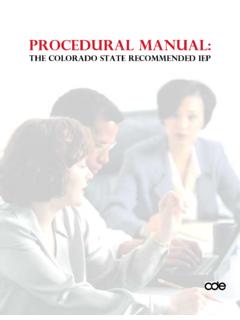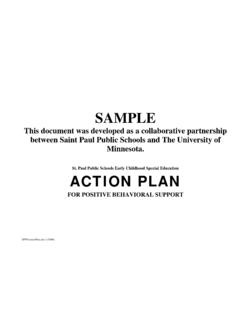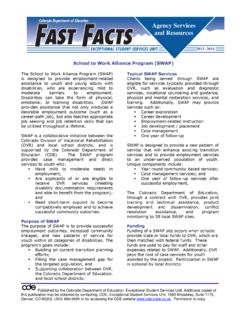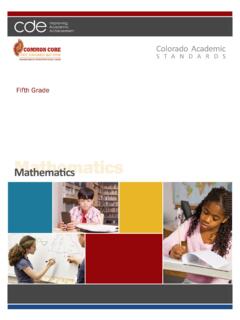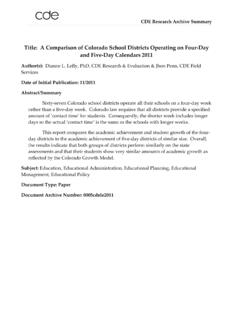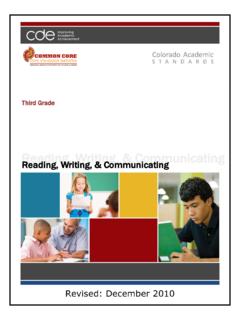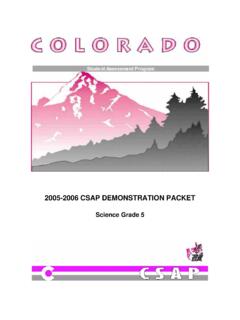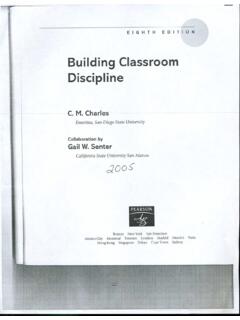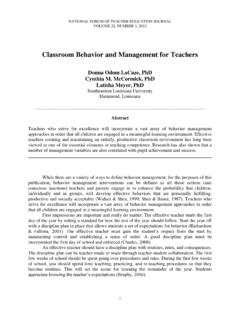Transcription of Effective Classroom Management Strategies for Use During ...
1 Effective Classroom Management Strategies for Use During Small Group Reading InstructionPresentation ByKathleen Beaudoin, of Washington, TacomaFrequently Cited Problem BehaviorszNot following along*zBlurting out responses*zDisturbing others* (including making noises & deliberately annoying others)zDelays in starting reading taskzOut of seatzNot prepared with materialszNon-CompliancezArguing Source: Survey of 48 elementary reading teachers*over 50% cited this problem as occurring at least frequently Effective Managementz .. Effective and ineffective teachers do not differ much with respect to how they handle discipline problems. Instead, they differ with respect to the number of discipline problems they encounter, the Effective teachers having fewer problems.
2 In operational terms, Effective teachers are likely to focus on antecedent control and establish a structure such that problems are less likely to occur Elliot, Witt, Kratochwill, & Stoiber, 2002. p. 244).Physical StructurezThe goal is to design a structure that allows the teacher to interact quickly and easily with all students. Respond consistently to minor misbehavior Respond to misbehavior before it escalates Engage frequently in positive interactionsPhysical StructurezConsider risk factors when determining arrangement. Grade level number of students reputation of class teacher experiencezOptimize for most common types of instructional necessary, train students in procedures for physically restructuring the : Sprick, R. S., Garrison, M., & Howard, L.
3 (1998). CHAMPs: A proactive and positive approach to Classroom Management . Eugene, OR: Pacific Northwest Started with Expectations for BehaviorzDefine expectations for group, independent & transition times. 5 or fewer Ex. hand raising times vs. free-talking timeszTeach Expectations. Teach to mastery Re-teach frequently zMonitor Correction : Expectations for Independent SeatworkzIndependent Seatwork Use level 1 voices. Work at your seat until assignment is complete. Raise your flag if you have a question, but continue to work. Place completed work on the corner of your desk. Read your book when finished with the 1: List 3-5 expectations for each of the following groupIndependent seatworkTransition timesTeaching ExpectationszDescribe the examples and the frequent opportunities to follow compliance.
4 ZUse corrective procedures that teach expectations Group and Independent Seatwork: Points to ConsiderzProvide instructions for independent seatwork before small group work small group instruction only after independent seatwork is going natural stopping points within the small group on-task independent workers while teaching the small group rather than : Points to ConsiderzPrepare all materials in advance and place them where they will be a signal to notify students of time remaining until student attention before transition instructions on how to make the transition and the expectations for positive corrective proceduresResponding to Specific Problem BehaviorszNot following along*zBlurting out responses*zDisturbing others* (including making noises & deliberately annoying others)Activity 2: What behaviors get in the way of teaching?
5 Responding to Problem Behavior: A Continuum of Strategies zEnsure the task is appropriatezAttend to appropriate behaviorszReinforcement of otherszGentle verbal reminderszProximity context for the predictable expected the behavioral strong reinforcement for expected behavior. expected the planA Continuum of Strategies reprimandszQuiet timezOwing timezNon exclusionary time-outzExclusionary time-outzThird party sanctions(Source: Mercer & Mercer, 1998)Verbal ReprimandszWhen reprimanding, tell the student what behavior is inappropriate and delivering a verbal reprimand, position yourself close to the student and speak in a quiet but firm verbal reprimands with StrategyStep 1. Require students to stop what they are doing 2. Require students to remain absolutely 3.
6 Maintain quiet time for 1 or 2 4. Remind students of rules and expectations for current 5. Have the students resume previous 6. Use reinforcement to maintain appropriate StrategyStep 1. Identify the behaviors/circumstances that will result in owing 2. Discuss situation with the offending 3. Determine how much time the student will owe. Step 4. Identify when students will owe From Positive ReinforcementStep 1. Define the behaviors that will result in time-out being 2. Decide location of the time-out 3. Implement time-out procedure 4. Determine the length of the time-out period. Step 5. Require the student to make up any work missed During 6. When the student is out of the time-out area, reinforce appropriate Note About PunishmentzPunish-based discipline does not improve school safety, learning or behavior.
7 (Source: National Association of School Psychologists, 2002, Fair and Effective Discipline for All Students: Best Practice Strategies for Educators)Final Word About Reinforcementz For the reinforcement to work, it has to be easier to get and be a better pay-off than the pay-off from the problem behavior .Source: Center for Effective Collaboration and Practice, 2000. Addressing Student Problem Behavior-Part III: Creating Positive Behavioral Intervention Plans and Supports.


